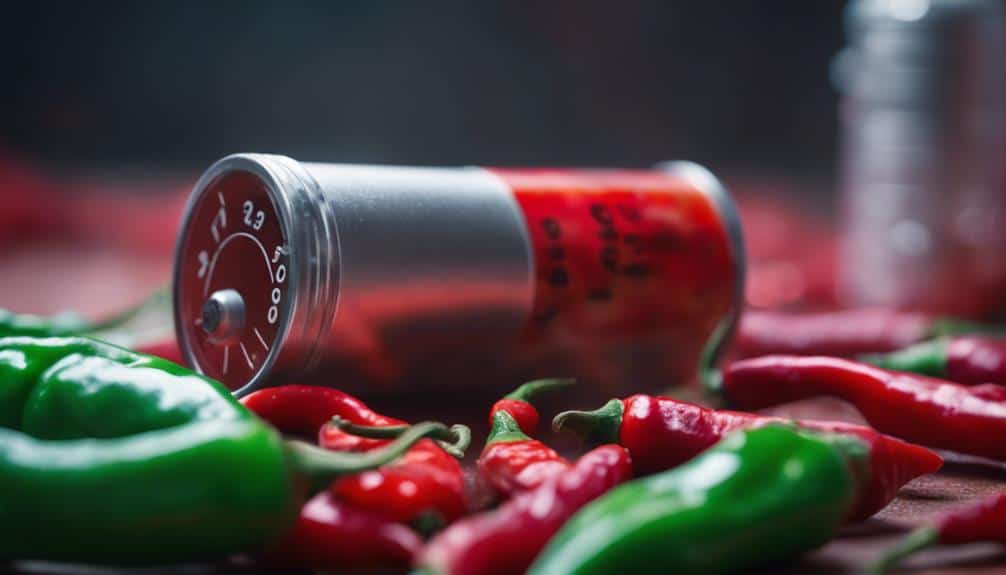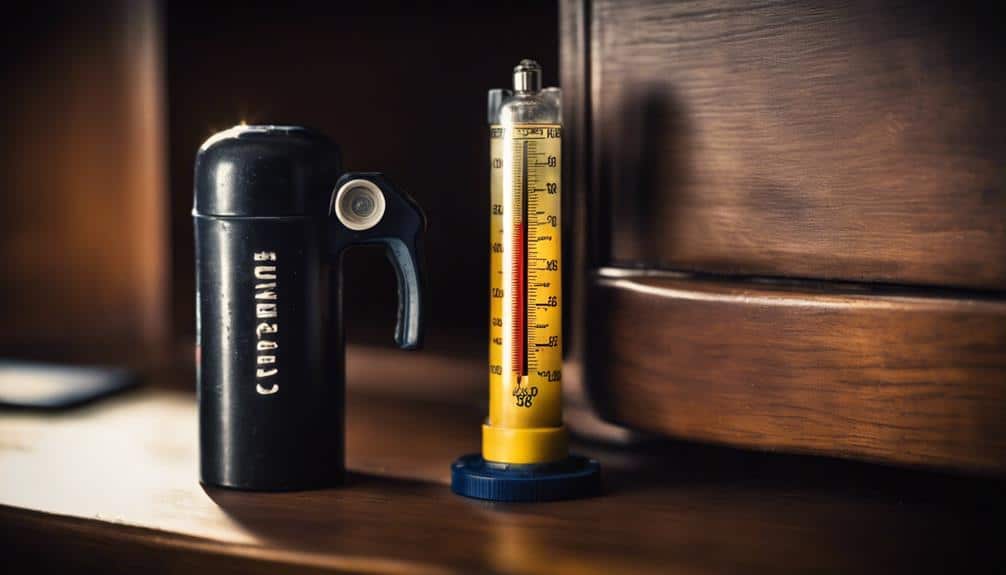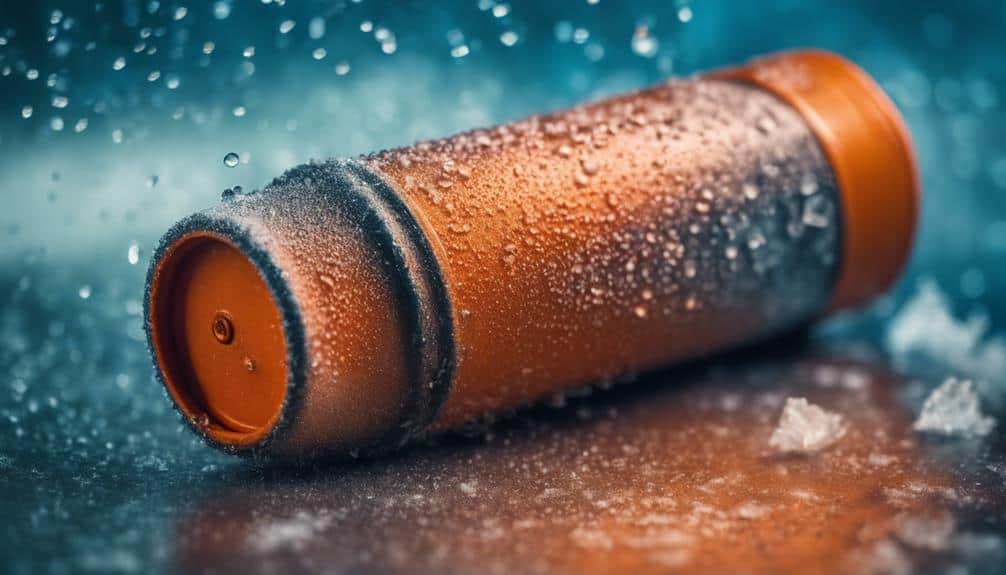Yes,
temperature can totally mess with your pepper spray! Imagine it’s a
sweltering day; the heat might cause the canister to leak or even burst—yikes! On the flip side, when it’s
freezing, the spray might not come out as strong, leaving you vulnerable. You’ve got to store it between 32°F and 120°F, no extreme heat or frigid cold. Don’t forget, direct sunlight can degrade the spray’s potency faster than you’d think. Regular checks,
proper storage, and a little care will go a long way in keeping your pepper spray ready for action. Want to make sure you’re prepared? Keep on exploring!
Composition of Pepper Spray
Pepper spray’s effectiveness hinges on its composition, primarily the active ingredient Oleoresin Capsicum (OC). Derived from the pepper’s placenta near the stem, OC is what gives pepper spray its powerful punch. You might think the percentage of OC is what matters most, but it’s actually the total
capsaicinoid content that determines how fiery your pepper spray is. Capsaicin, the spiciest of the bunch, plays the starring role.
Most
civilian pepper sprays pack between 0.18% to 1.33%
major capsaicinoids, while
bear sprays are even hotter, with 1.0% to 2.0%. Five major capsaicinoids make up OC, but capsaicin is the heavyweight champion. For instance, the
Pink Leopard Pepper Shot offers a stylish yet powerful defense mechanism.
However, the way you
store your pepper spray can make or break its performance. If you expose it to
extreme temperatures, you risk degrading those vital OC components. Imagine trying to fend off an attacker with a dud canister—yikes! Keeping your pepper spray at a stable temperature guarantees it’s ready when you need it.
Also, don’t forget the
expiration date. Over time, even the best-stored spray can lose its oomph. So, regularly check your pepper spray’s expiration date to keep it
effective.
Temperature Impact on Efficacy
When considering the composition of pepper spray, it’s clear that maintaining its fiery potency is key. You can’t just throw your pepper spray anywhere and hope it works when you need it. Store it between 32°F (0°C) and 120°F (48.88°C) to keep it effective. Excessive heat can cause the canister to leak or burst, which could lead to some seriously unwanted surprises. Imagine you’re in a hot car, and suddenly your pepper spray explodes—yikes!
Cold temperatures aren’t any better. They can reduce the performance of your pepper spray, so when you need it most, it might just fizzle out instead of giving you that powerful burst. Regular testing every 90-180 days is a good practice, especially if it’s been exposed to extreme temperatures. The oleoresin capsicum, the active ingredient, can degrade with prolonged sunlight exposure, making your spray less effective over time.
Here’s a quick guide to help you understand how temperature impacts your pepper spray:
| Temperature Range |
Risk |
Impact on Efficacy |
| Below 32°F |
Reduced performance |
Less effective spray |
| 32°F – 120°F |
Ideal storage |
Maintains efficacy |
| Above 120°F |
Canister may leak or burst |
Potential harm and damage |
| Prolonged Sunlight |
Degrades oleoresin capsicum |
Reduced potency over time |
Safe Storage Practices
To guarantee your pepper spray remains effective and safe, it’s crucial to follow
proper storage practices. You want to store your SABRE pepper spray at
room temperature, ideally between 32°F (0°C) and 120°F (48.88°C). This helps prevent leaks or bursts caused by excessive heat or cold, which could be a real mess. Remember,
direct sunlight is a no-go. Sunlight can degrade the
active ingredient, oleoresin capsicum, making your pepper spray less effective. This is especially important for products designed for
outdoor activities.
Regularly check the
expiration date too. Most pepper sprays have a
shelf life of 2 to 4 years. Imagine needing to use it in an emergency and finding out it’s expired—that’s a nightmare scenario you definitely want to avoid. For vehicle storage, avoid
high-heat areas like under car seats or glove compartments that get a lot of sun. Instead, opt for door compartments or other
cool, dark spots.
When carrying pepper spray, these safe storage practices guarantee it’s always ready to go when you need it. So, keep your pepper spray in the right conditions, and you’ll have peace of mind knowing it’s effective and reliable.
User Experiences
Users’ experiences with
storing pepper spray, particularly
MACE, offer valuable insights into its reliability across varying conditions. Many have successfully stored their pepper spray in cars for long stretches without a hitch. However, some folks are a bit jittery about
freezing temperatures potentially messing with the spray’s performance. Visualize opening your glove box, fingers crossed that your trusty MACE hasn’t transformed into a glorified popsicle! It’s worth noting that
UV identifying dye in some pepper sprays can also be affected by extreme temperatures.
Anecdotes from users reveal that storing pepper spray on door shelves is usually fine, but
accidents do happen. Envision this: you’re rummaging through a cramped space, and oops!
Accidental activation. It’s a pungent reminder to handle your pepper spray with care.
Some users stress the importance of
monitoring the temperature in your vehicle. Sure, your pepper spray might seem effective despite temperature fluctuations, but it’s wise to keep an eye out to avoid
leaks or, worse, explosions. Think of it as babysitting your pepper spray—attention to details matters.
Personal experiences vary, but the consensus is clear: be aware of
environmental conditions. Extreme heat and cold can impact reliability, so
regular inspections and a bit of TLC can go a long way in ensuring your pepper spray is always ready to protect.
Maintenance Tips
You’ve gotta keep your
pepper spray in top shape, so make certain you
test it every 90-180 days to see if it’s still working and has enough left. When testing, ensure the safety lock is properly engaged before and after use to prevent accidental discharge. Store it in a cool, dark place at room temperature to keep it potent and ready for action. Remember, don’t forget to check the
expiration date—nobody wants to reach for their spray in an emergency and find out it’s expired!
Regular Functionality Testing
Regular functionality testing is essential to guarantee your pepper spray is always ready for use. Imagine reaching for your pepper spray in a critical moment, only to find it doesn’t work—nightmare! To avoid this, you should test your pepper spray canister every
90-180 days. Cold may cause the spray to lose its
effectiveness, so always store your
pepper spray in environments above 32°F. On the flip side, never really let it exceed 120°F to avoid any potential mishaps.
Before testing, inspect the canister for any
signs of damage or wear. A dented or expired canister could spell trouble. During your
regular functionality testing, be mindful that each test uses up some of the contents. So, keep an eye on the levels and
replace the canister if it’s running low. Regular checks can
prolong its lifespan, ensuring it’s reliable when you need it most.
Proper Storage Conditions
The longevity and effectiveness of your pepper spray can hinge on proper storage conditions. You might not think about it often, but how and where you keep your pepper spray makes a huge difference. First off, avoid extreme temperatures. Storing your canister in a place that gets too hot or too cold can cause leaks or bursts, which you definitely don’t want. Additionally, consider the
effective range of the spray, as improper storage can potentially alter this.
To keep things simple, here are a few tips:
- Store it in a cool, dark location like a drawer or cabinet.
- Avoid direct sunlight to prevent the oleoresin capsicum (OC) from degrading.
- Regularly check the canister for integrity and replace it if it shows signs of damage or is past its expiration date, typically between 2 to 4 years.
Don’t leave it in your car. The interior of your vehicle can easily exceed the safe storage limits, leading to potential canister failure. By keeping your pepper spray in a stable environment free from temperature fluctuations, you guarantee it stays ready for use when you need it the most. So, treat your pepper spray like a fine wine—store it properly, check it often, and it’ll be there when you need it.
Legal Considerations
Steering through the legal landscape around pepper spray can feel like walking through a minefield. The legal status of pepper spray varies wildly from state to state, and it’s vital to know the rules in your area. For instance, in Massachusetts, you need a License to Carry (LTC) or Firearms Identification Card (FID) if you want to possess certain products like the Kimber PepperBlaster II. Shipping restrictions also exist in several states, making online purchases tricky.
Here’s a handy table to break down some of the complexities:
| State |
Requirement |
| Massachusetts |
LTC or FID |
| California |
Shipping limits |
| Florida |
Shipping limits |
| Michigan |
Max capsaicinoid content |
| New York |
Shipping limits |
Knowing the proper use of pepper spray is just as important. Using it in non-self-defense situations can lead to serious legal consequences, including criminal charges or liability issues. Local legal statutes also govern the use of sprays approved by the EPA or Health Canada for aggressive dogs. Ignoring these regulations can land you in hot water.
Frequently Asked Questions
Can Pepper Spray Be Kept in a Hot Car?
Imagine a ticking time bomb. You shouldn’t keep pepper spray in a hot car due to safety concerns. For ideal container integrity and product lifespan, store it in cooler places, follow legal regulations, and check its effectiveness duration regularly.
Does Pepper Spray Go Bad in Heat?
Yes, heat exposure affects pepper spray lifespan considerably. High temperatures can compromise canister integrity, leading to efficacy reduction. To guarantee safety and effectiveness, follow storage recommendations and avoid leaving it in hot environments. Safety precautions are essential.
What Is the Maximum Temperature for Pepper Spray?
Imagine you left pepper spray in your car on a hot day. The maximum temperature for pepper spray is 120°F. For maximum effectiveness and safety, follow these guidelines to guarantee ideal shelf life, temperature stability, and aerosol canister integrity.
Can Pepper Spray Be in the Cold?
You shouldn’t store pepper spray in freezing conditions. Cold weather effects can reduce pepper spray efficacy and performance. Below the freezing point, it may not work properly. Follow storage recommendations and test it regularly to guarantee it’s effective for outdoor usage.








2 Responses